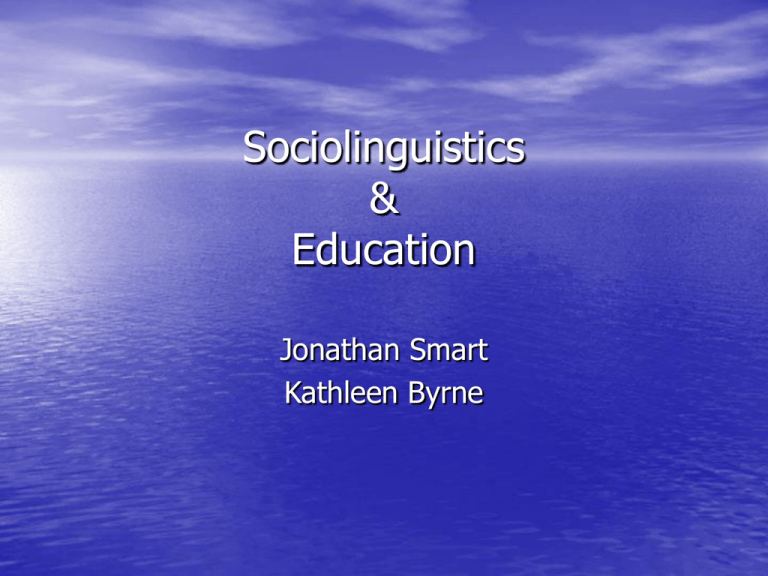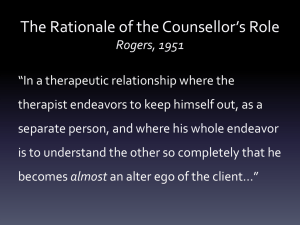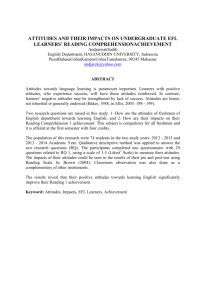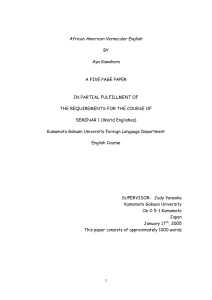Sociolinguistics & Education
advertisement

Sociolinguistics & Education Jonathan Smart Kathleen Byrne What is Educational Sociolinguistics? Educational sociolinguistics is the subfield of sociolinguistics dealing with relationships between language and education. Research examines: • Relationships within classrooms • Informal education • Community- centered instruction • Media/Long-distance education In every society there is information that members need to know, and skills they need to acquire in order to meet the responsibilities and obligations of citizenship. TRIBAL SOCIETIES STATE SOCIETIES • Supervised by elders • Assigned to a local institution • Ceremonies mark entrance into adulthood • Knowledge may not be consistent with what is • Imitation of skilled • artisans for continuation of arts & crafts Encouragement of community centered communication • learned in the home or community Home/school language & cultural differences are one source of educational problems Classroom Language • Language is heavily regulated o Teacher talk dominates in the classroom o Teacher determines the topic and each student’s right to speak on that topic o Students must maintain the teacher’s language expectations, otherwise their right to speak is terminated ‘Old Ironsides’ (Dorr-Bremme 1984) Classroom Language • Conflicting Definitions of Purpose: o Oral communication differences More context dependent Less repetition and redundancy More fragmented answers o Written communication differences Less context dependent Lots of repetition and redundancy Letter to a pen-pal (Soloman 1995) Structure & Culture in Classroom Conversations • Typically question-asking & answering • Mehan’s IRE structured sequence – Initiation usually by the teacher in the form of a request for information – Response from one of the students – Evaluation of the response by the teacher followed by a request for more information or a new IRE sequence Disadvantage & Classroom Language • Differences between classroom language and home/community language and cultural differences create problems in the classroom. – Ute cultural language expectations – Class/Race expectations • Activity The Ways with Words Experiment • Heath (1983) in SC compared home language of • • • m-class whites, w-class blacks, and w- class whites. M-class whites read with children and ask questions W-class whites read to their children (fewer questions) W-class blacks no reading or one-on-one exchanges, but encourage autonomous thought. Basil Bernstein’s Research • Students from different social and economic backgrounds respond differently to classroom experiences • Speakers learn the language that is relevant to their social status thereby learning the requirements and restrictions that regulate behavior within that social position. These he termed ‘codes’ Elaborated Codes • • • • Elaborate Codes Associated with the middle- class Access to a wide range of syntactic and semantic alternatives Encouraged to use these options in imaginative and unpredictable ways As a result they have a precise, highly creative, & richly expressive speech descriptions • • • • • Examples of Use Explicit Expressive Ability to conceptually organize experiences Favors complex sentences Employs a large vocabulary by using all parts of speech Restricted Codes Restricted Codes • Associated with the working- class & other marginalized groups • Access to a limited range of linguistic options • As a result they have a limited range of opportunities within society Examples of Use • Uses minimal linguistic resources: – Sentences are usually short – Links between sentences are repetitive and predictable (and then, so, next) – Infrequent & un-detailed use of adjectives & adverbs • Often elicit constant confirmation for their statements – You know Results of Bernstein’s Work • ‘Deficit Hypothesis’ – Poor performance of minority and workingclass students due to a language deficit or ‘verbal deprivation’ – Equivalent to not having a language – Schools attempted to ‘teach language’ Viewed as being racially motivated Stereotypically assumed the varieties of English used by minority were inferior Labov’s Research • Revealed the logic behind the non- standard AAVE use of the verb: to be – AAVE sentences that allow the deletion of the verb be correspond to SAE sentences that use the contracted form of the verb be • She --- the first one & She’s the first one – AAVE sentences that do not allow the deletion of the verb be, are equivalent to SAE sentences where contractions are not allowed • *Who’s it? & Who --- it? Persistent Problems • Trudgill – Problem lies with school expectations – School system should change in order to be more flexible to adapt to the needs of the students • Bourdieu – Argues that the problem is not in the stratified codes that promote disadvantage – Schools are used for ‘social reproduction’, meaning they are used to maintain class structure to restrict student’s future opportunities for advancement Continued Effects of Classroom Language The power, regulation, and control of classroom language is shown through teacher-student communication and is central to the students’ success or failure Dialect & Language Choice In the Classroom • Which should be language of instruction? • Easy in monolingual countries (except for classical languages) • Questions of choosing language of instruction is linked to “possibilities of social and educational change” (Mesthrie p. 368). UNESCO: Vernacular in Education • Committee 1951-1953 published report (see Mesthrie 369-370), reconsidering the validity of ‘vernaculars.’ • Critics objected to impracticality of many of the committee’s suggestions. • Balance capability of extant language to deal with education with advantages of using ‘mother tongue’ Very Smooth Transition Language attitudes, motivation, and standards • McGroarty (1996) “Language is an intimate part of social identity” • Teachers must balance teaching responsibility w/ respect for language that students bring to class. • In examining motivation, etc, hard to determine what are results vs. causes Students are affected by: (discussion) 1. Effective strategies for learning 2. Attitudes/examples of peers, teachers, parents towards language study 3. Social/Institutional language policies as reflected in classroom 4. Status of the language in society 5. Personal attitudes & motivations of students themselves and teachers. Definitions • Attitude: “involves beliefs, emotional reactions, and behavioral tendencies related to the object of the attitude” (p 5). • Motivation: “combination of desire and effort made to achieve a goal” (p 5) Measuring the abstract • Gardner & Lambert (1959, 1972) gave self-report questionnaires about the language, the language speakers, etc. • Then subjects were asked to rate speakers’ samples based on unrelated qualities, judging between language varieties (but actually same speakers). Orientation Index • Index of motivation: initial distinction, still widely used in psychology: • Intrinsic motivation: based within the individual • Extrinsic motivation: individual’s perception of external rewards for action Motivation constructs • Orientations of motivation: • Integrative: the desire to be like and interact • • with speakers of the target language. Instrumental: desire to learn language to achieve a goal such as academic/occupational success (p 7) Later Research: Orientation is indirect i/o direct influence on achievement (p 8) New Research (Baker, 1992) • Indicators of attitude: gender, age, language background, type of school attended, local youth culture, etc. • These factors shape attitudes, which are also influenced by language ability. Problems with Research • Question of causality • Operational definitions (of motivation) are too narrow to apply. • “Classroom is treated generically” (p 9). Recent Methods • Newer studies correlate questionnaires with self-reported risk taking. • Newer research has made an effort to integrate broader (beyond the L2 classroom) personality factors (e.g. using Meyers-Brigg type indicators). • Tried to incorporate general educational, industrial-occupational, and social learning theory. Summary Relationship Language learning depends on the interaction between 3 broad factors: 1. The Person and relevant indicators 2. The Nature of Instruction Received 3. The Broader Language Learning Context Enter DVD Accommodation Theory • (Giles et al, 1979, 1991) • Convergent: “factors related to feeling of solidarity” wherein a speaker is reinforced to use increase prestige/standard variants • Divergent: using marked features to “emphasize a distinctive social identity” (p 12) Attitudes & Education • Attitude no longer studied as single determinative factor in learning. • Linked to other factors: perceived competence, personal & academic selfesteem, beliefs about community of target language. Student & Parent Attitudes • Attitudes are shaped by personal experiences • • • and their specific learning context ESL students will not all have the same attitude towards learning a new language; however, parents typically want their child to be bilingual Students using a non-standard English dialect comprehend SAE after 4-5 years of formal education Problems arise when SAE speaking teachers cannot understand students using non-standard dialects Student & Parent Attitudes • Controversy is typical when the community • • • • language is different than the school language When marginalization or oppression is a historical aspect of the community being bidialectic is seen as positive/necessary Distinction between learning community dialect at home and school/standard dialect is also positive Some aspects of community dialect integrated in school language is helpful Prohibition of community language is unjustified Language Attitude Studies • Acquiring a second language does not improve social attitudes towards that culture • Emotional factors are involved in students’ intrinsic motivation • Students may become discouraged due to the length of the acquisition process Choices of Norms & Standards • Descriptive Norms- what speakers use most often • Prescriptive Norms- rules applied to language use in all settings • Language Standardization- process over time involves selecting a norm, elaboration for different uses, restriction of diversity, & codification in grammar or dictionaries Standards In Schools • Norms are established by the dominant culture group • Enforced in schools through standardized language use • Historically teachers promote ‘correct language’ equivalent to standardized English • Currently history, geography, & political and commercial relationships are influencing accepted norms Language Policies • Language policies & instruction shape attitudes towards language • Language policies shape political attitudes due to power struggles between dominant and minority groups Educational Implications • Find ways to motivate speakers at the individual, • • • classroom, and school wide level Promote the relevance of language instruction and the real world Expand opportunities for diverse language forms As conflict and disagreements over language continues teachers need to provide creative and effective changes











